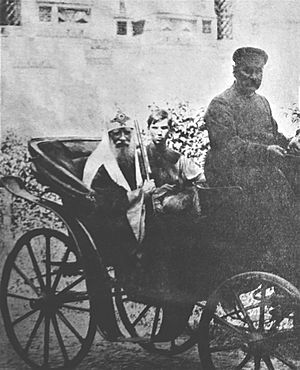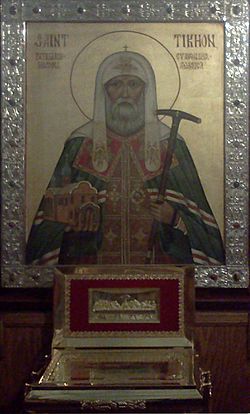Patriarch Tikhon of Moscow facts for kids
Quick facts for kids SaintTikhon of Moscow 11th Patriarch of Moscow and of All Russia |
|
|---|---|
 |
|
| Confessor, Patriarch, Wonderworker and Apostle to America |
|
| Born | Vasily Ivanovich Bellavin 31 January 1865 Klin, Toropets District, Pskov Provence, Russian Empire |
| Died | 7 April 1925 (aged 60) Moscow, Russian SFSR, Soviet Union |
| Venerated in | Eastern Orthodoxy, Episcopal Church (USA), Anglican Church in North America |
| Canonized |
|
| Major shrine | Donskoy Monastery, Moscow |
| Feast |
|
Tikhon of Moscow (born Vasily Ivanovich Bellavin) was an important leader in the Russian Orthodox Church. He was born on January 31, 1865, and passed away on April 7, 1925.
In 1917, he became the 11th Patriarch of Moscow and All Russia. This was a very important role, as the church had not had a patriarch for about 200 years. Tikhon is honored as a confessor by the Russian Orthodox Church. This means he showed great faith even when facing difficulties.
Contents
Early Life and Education
Vasily Ivanovich Bellavin, later known as Tikhon, began his studies in 1878. He attended the Pskov Theological Seminary until 1884.
In 1888, when he was 23, he finished his studies at the Saint Petersburg Theological Academy. After graduating, he returned to the Pskov Seminary. There, he became a teacher of Moral and Dogmatic Theology.
In 1891, at age 26, he became a monk and was given the name Tikhon. This name honored Saint Tikhon of Zadonsk. A few years later, in 1897, Tikhon became the Bishop of Lublin.
Serving in America
On September 14, 1898, Tikhon was sent to the United States. He became the Bishop of the Aleutian Islands and Alaska. He even became an American citizen.
Bishop Tikhon traveled a lot to visit Orthodox communities. These communities were growing in many American cities. He visited places like New York City, Chicago, and cities in Pennsylvania and Ohio.
In 1900, he reorganized his diocese in North America. He changed its name to "Diocese of the Aleutian Islands and North America." He had two helpers, called auxiliary bishops. These were Bishop Innocent in Alaska and Saint Raphael in Brooklyn.
Tikhon helped build many churches in North America. On May 22, 1901, he blessed the start of St. Nicholas Cathedral in New York City. He also helped build the church of St. Nicholas in Brooklyn for Syrian Orthodox immigrants in 1902. He worked to connect with Greek Orthodox churches in America.
While in the United States, Tikhon learned about the country's many different religions. He also saw how different Christian groups were trying to work together. He understood the needs of many immigrants from Eastern and Southern Europe.
In 1905, Tikhon was given the title of Archbishop. He moved his main office from San Francisco to New York. In June 1905, he approved the creation of a monastery in Pennsylvania. This was St. Tikhon's Monastery.
Back to Russia: A New Role
In 1907, Tikhon returned to Russia. He was appointed to lead the Diocese of Yaroslavl. Later, in 1913, he moved to the diocese of Vilno in Lithuania.
However, the First World War and the Russian Revolution caused great trouble in Russia. On June 21, 1917, church leaders and people chose Tikhon to be the main bishop of Moscow.
On August 14, 1917, Tikhon became the Metropolitan of Moscow. The next day, a major church meeting began in Moscow. This was the first such meeting in over 200 years.
A very important decision was made on October 28, 1917. This was just days after the Bolsheviks took power. The council decided to bring back the role of Patriarch in the Russian Orthodox Church. On November 5, 1917, Tikhon was chosen to be the new Patriarch of Moscow and All Russia.
As Patriarch: Challenges and Changes
During the Russian Civil War, the new government saw the church as an enemy. Many bishops were sent away, put in prison, or even killed. Patriarch Tikhon spoke out against the deaths of the royal family in 1918. He also protested against the attacks by the Bolsheviks on the church.
In 1920, he gave independence to the Orthodox Church in America. This allowed them to manage themselves while the church in Russia faced difficulties.
In November 1921, some Russian bishops who had left Russia gathered in Sremski Karlovci, Serbia. They made statements against the Bolsheviks. In May 1922, Tikhon and his church leaders officially separated from this group. This group continued as a separate church.
In 1922, Russia faced a terrible famine. The government used this situation to take church property. They also accused the patriarch of causing problems. From April 1922 to June 1923, he was held under house arrest at Donskoy Monastery. His protests against taking church property were called a crime. This caused concern around the world, and several countries sent protests to the Soviet government.
Under pressure, Tikhon sent messages saying he was "no longer an enemy to the Soviet power." Even with this, he was still trusted by the Orthodox community in Russia. In 1923, a government-supported group tried to remove Tikhon from his role. They said he was "henceforth a simple citizen." However, the Russian Orthodox Church never accepted this decision.
Final Years and Passing
In 1924, Patriarch Tikhon became ill and was hospitalized. On April 5, 1925, he led his last church service. He passed away two days later, on April 7. This day is also the Feast of the Annunciation.
He was buried on April 12 in the winter church of Donskoy Monastery in Moscow. After his death, many people believed he was a martyr or confessor for his faith.
Becoming a Saint
Tikhon was declared a saint by the Synod of Bishops of the Russian Orthodox Church Outside of Russia on November 1, 1981. This happened during a special event honoring new martyrs and confessors.
Later, the Moscow Patriarchate also declared him a saint on October 9, 1989. This event showed an improvement in relations between the church and the Soviet government during the Glasnost era. The American Episcopal Church and the Anglican Church in North America remember Tikhon on April 7, the day he died.
People thought Saint Tikhon's relics (his remains) were lost. But on February 19, 1992, his coffin was found in a hidden room at the Donskoy Monastery. On February 22, the coffin was opened, and his relics were found to be almost perfectly preserved.
The relics were placed in a special container. On April 5, 1992, fifty bishops solemnly moved them to the main church of the Donskoy Monastery. They were placed in a place of honor near the altar.
Images for kids
See also
 In Spanish: Tijon de Moscú para niños
In Spanish: Tijon de Moscú para niños
- Anti-religious campaign during the Russian Civil War
- Persecution of Christians in the Soviet Union
- Religion in the Soviet Union
- USSR anti-religious campaign (1921–1928)
- List of American Eastern Orthodox saints





